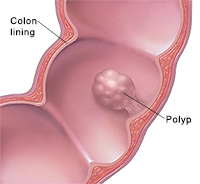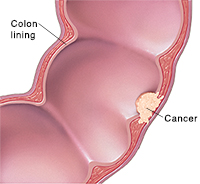The colon (also called the large intestine) is a muscular tube that forms the last part of the digestive tract. It absorbs water and stores food waste. The colon is about 4 to 6 feet long. The rectum is the last 6 inches of the colon. The colon and rectum have a smooth lining composed of millions of cells. Changes in these cells can lead to growths in the colon that can become cancerous and should be removed.
 |
| The colon has a smooth lining composed of millions of cells. |
When the Colon Lining Changes
Changes that occur in the cells that line the colon or rectum can lead to growths called polyps.Over a period of years, polyps can turn cancerous. Removing polyps early may prevent cancer from ever forming.
Polyps
Polyps are fleshy clumps of tissue that form on the lining of the colon or rectum. Small polyps are usually benign (not cancerous). However, over time, cells in a polyp can change and become cancerous. Certain types of polyps known as adenomatous polyps are premalignant. The risk for invasive cancer increases with the size of the polyp and certain cell and gene features. This means that they can become cancerous if they're not removed. Hyperplastic polyps are benign. They can grow quite large and not turn cancerous.
 Cancer
Cancer
Almost all colorectal cancers start when polyp cells begin growing abnormally. As a cancerous tumor grows, it may involve more and more of the colon or rectum. In time, cancer can also grow beyond the colon or rectum and spread to nearby organs or to glands called lymph nodes. The cells can also travel to other parts of the body. This is known as metastasis. The earlier a cancerous tumor is removed, the better the chance of preventing its spread.














